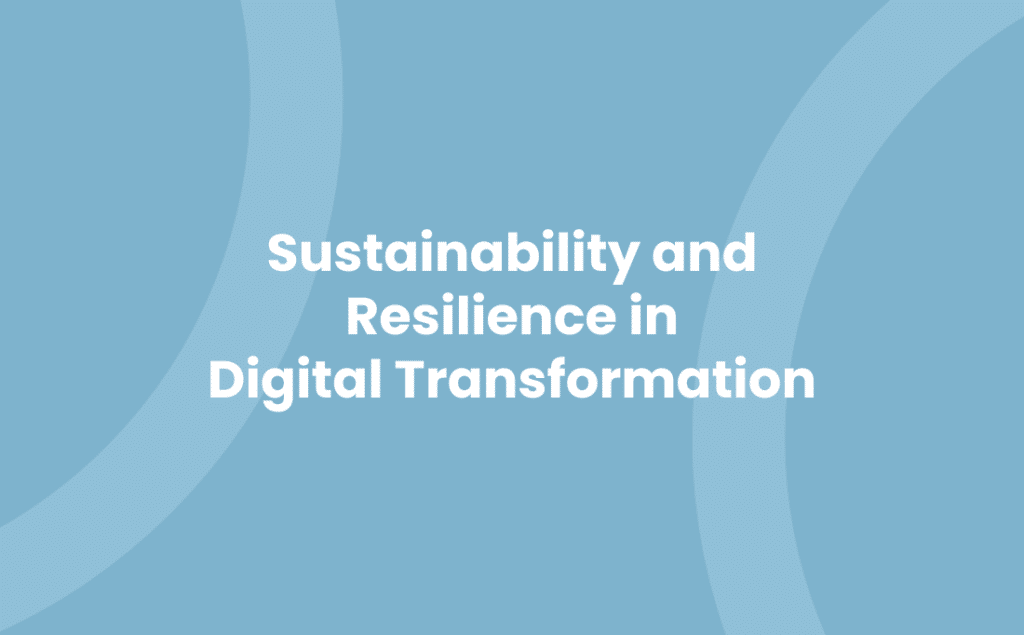Welcome to the digital age, where technology isn’t just an add-on, it’s a necessity. As you navigate this era, you’ll likely encounter the term ‘Digital Transformation Sustainability’. But what does it mean, and why does it matter?
In a nutshell, it’s about ensuring that your business’s digital transformation journey is not just a one-time event, but a sustainable, ongoing process. It’s about leveraging technology to drive long-term growth and resilience. In this article, we’ll delve deeper into the concept, exploring its importance and how you can achieve it. Strap in, because we’re about to take a closer look at the future of business.
Understanding Digital Transformation Sustainability
If digital transformation is the journey, then digital transformation sustainability is ensuring the car’s got filled up with petrol to make it everlasting. It’s about making digital technology a consistent element in the business playground, keeping sight of its impact even as it evolves.
Seeing this concept in action offers a fresh perspective on business strategies. Rather than thinking of digital transformation as one-off change, consider it an ongoing commitment. It’s similar to owning a car; purchasing it is just step one. It requires regular servicing and upgrades for optimum performance. In the same vein, digital transformation sustainability isn’t a checkbox, it’s a groove on a vinyl record; you’ve to maintain and play it continuously to enjoy the music.
Applying digital sustainable practices involves focusing on the long term. It insists on thinking past immediate digital successes and keeps you engrossed in creating continual growth. It’s about harnessing technology to not only cope with a challenging business environment but also to thrive in it. For instance, imagine a car manufacturer that continually integrates new technologies to improve its vehicles or services. From a Bluetooth connectivity function to a sophisticated GPS system, it works to remain relevant and useful.
Adapting to digital transformation sustainability means equipping for a trip almost as adventurous as a tumble down the rabbit hole. Firms might find themselves redefining and re-designing processes, training employees in new digital skills, or embracing technologies that, only a decade ago, were just the stuff of sci-fi movies.
At heart of sustainable digital transformation lies the balance between short-term goals and long-term objectives. Although the thrill of quick wins is tempting, the vision should extend beyond the immediate horizon.
Ensuring digital transformation sustainability might feel like a magic trick, but with a grasp of its ins and outs, it becomes a strategic tool. Technology continues to evolve, and businesses must evolve with it to remain resilient, relevant, and ready for what’s next. This ensures they’re not just passengers in their own vehicles, but skilled drivers, continually learning, adapting, and ready for any turn on the road of digital transformation.
Digital Transformation and Business Sustainability
Notably, attention focuses on how digital transformation sustainability works as a catalyst for business sustainability. Astoundingly, your business survival hinges over mastering digital transformation processes to fortify long-lasting growth. This essential gear in the wheel represents the tech-enhanced path businesses take towards sustained success.
Interestingly, several models and frameworks help businesses steer their way through this complex digital terrain. For instance, the Sustainability Balanced Scorecard assists in integrating sustainability into every layer of the business, aiding in maintaining a high performance.
Moreover, fostering a ‘digital-first’ mindset empowers your employees to embrace digital avenues, improving operational efficiency. Upskilling employees to adapt to digital scenarios becomes a critical facet, contributing to the overall sustainability.
Additionally, reimagining and redesigning traditional business processes to incorporate digital elements lead to optimised resource usage. For instance, paperless operations reduce waste and contribute to environmental preservation, a crucial element of sustainability.
On the other hand, building a sturdy digital infrastructure empowers your business to withstand disruptions. Having resilient digital systems in place guarantees operational continuity, irrespective of external factors, driving your business steadily towards long-term objectives.
Finally, staying abreast of technological advancements positions your business on the edge of relevance. By integrating cutting-edge digital tools and tech trends into your business strategies, you assure a place in the competitive market while paving the path for continuous evolution.
In sum, for sustainable growth in the business arena, mastering the art of digital transformation becomes imperative. It’s pivotal to balancing short-term profitability with long-term business objectives. Ultimately, those who flawlessly blend digital strategies with sustainability core values secure a promising position in this digital age of commerce.
Steps to Make Digital Transformation Sustainable
Embarking on a journey towards digital transformation sustainability requires a clear roadmap. You might wonder what it constitutes. Let’s dive straight into the process.
- Align digital strategy with sustainability: To attain digital transformation sustainability, your primary focus remains tying your digital approach with your sustainability strategy. This alignment cements your brand’s groundwork for long-term sustainability. Take Unilever, for instance, it’s ‘Sustainable Living Plan’ integrates digital innovation with environmental responsibility as a part of its business ethics.
- Incorporate digital feedback loop: It’s critical to create a digital feedback mechanism, ensuring direct insights from various data points. Walmart’s real-time analytics platform offers a fine example of examining customer purchasing patterns, aiding in inventory management.
- Strengthen digital infrastructure: Your business’s resilience relies heavily on a secure and scalable digital backbone. The global e-commerce giant Amazon showcases this by hosting servers around the world to guarantee uninterrupted service.
- Invest in workforce upskilling: To exploit advancing technologies, it’s essential to equip your workforce with necessary skill sets. Companies like AT;T have initiated extensive employee upskilling programs to promote a digital-friendly culture.
- Promote a digital-first mindset: A shift in thinking represents half the battle won. Encouraging a digital-first culture, as Airbnb does, enables utilisation of technology to its full potential, leading to ongoing efficiency.
- Balance short-term gains with long-term objectives: Remember to devote time to immediate gains, while not losing sight of long-term objectives. Netflix is a prime example, maintaining its dominance in the streaming industry by iterating its product offerings and consistently improving the platform.
Each of these steps contributes towards establishing a sustainable digital transformation. Success doesn’t occur in a day. Being methodical in your approach, maintaining resilience in face of changes, and continually adapting to evolving technologies lays the foundations for a truly sustainable digital transformation.
Major Challenges in Digital Transformation Sustainability
Venturing forth into the world of digital transformation sustainability presents several distinct obstacles. Each one of these can be likened to a roadblock, stopping you from efficient execution and maximising benefits. Recognising these challenges is the first step towards overcoming them, propelling your business towards a more sustainable future. Here, we detail some of the most prevalent ones.
- Difficulty in Keeping Up with Rapid Technological Advancements: Technological progress is swift, and if you don’t stay ahead, you may fall behind. Businesses often find it tricky to keep up with new digital trends, leading to outdated practices and missed opportunities.
- Resistance to Change from Employees: Often, individuals resist change. Employees may be reluctant to learn new digital tools and change their ways of doing their tasks, leading to resistance in digital transition; this forms a significant hurdle in your pursuit of digital transformation sustainability.
- Lack of a Well-Defined Digital Strategy: A lack of a clear digital action plan can leave your business drifting in the realm of digital transformation. You must set clear goals, timelines, and measurable KPIs for the initiative.
- Cybersecurity Threats: The digital age is not impervious to threats. Ensuring secure digital practices is critical, hence the cyber threat forms a noteworthy challenge.
- Scalability Issues: Not all digital solutions are scalable. Affixing solutions that can’t grow with your business can prove costly in the long run.
- Insufficient Digital Skills: A skills gap often exists in businesses embarking on their digital transformation journeys. Training employees on new software, coding languages or digital practices form a considerable challenge.
In navigating the complex waters of digital sustainable transformation, understanding these challenges helps chart a path to make your transformation efforts more sustainable, effective and beneficial. Thus, managing these obstacles is essential for the success of your journey towards digital transformation sustainability.
Technological Trends Supporting Digital Transformation Sustainability
Emergence of AI and Machine Learning
Artificial Intelligence (AI) and Machine Learning (ML) stand as primary catalysts in the landscape of digital transformation. By leveraging these technologies, businesses optimise operations, rendering them both efficient and sustainable. As an example, predictive maintenance powered by AI aids companies in reducing downtime, extending the lifespan of equipment, hence driving sustainability in operations.
Role of Big Data Analytics
Big data analytics plays a significant role in creating sustainable digital transformation. It supplies businesses with insights from large data-sets, aiding decision-making processes. As an illustrative point, customer behaviours can be analysed and used to design products that better cater to their needs, a critical step towards longevity and sustainability.
Shift towards Cloud Computing
Cloud computing paves the way for flexibility and scalability, elements intrinsic to sustainability. It provides businesses with reliable, uninterrupted access to data and applications. In turn, this allows for smooth business operation, irrespective of location constraints, positioning firms for sustained success in their digital journeys.
IoT and Smart Devices
The Internet of Things (IoT) and smart devices anchor businesses firmly in the digital era, equipping them with tools for success. They offer businesses the ability to connect and control a wide range of devices remotely. For instance, with smart thermostats, businesses can manage their energy consumption more efficiently, nudging them closer to sustainability goals.
Cybersecurity Systems
In an increasingly digitised world, safeguarding data integrity is paramount. Adoption of advanced cybersecurity systems contributes significantly to the sustainability of digital transformation. Such systems provide a safe environment in which businesses can operate, reducing potential threats and disruptions.
Being familiar with these technological trends, your business thrives even amid rapid technological changes. Thus, they are key components in the quest for digital transformation sustainability.
Conclusion
You’ve seen how digital transformation sustainability is akin to refuelling your car for endless journeys. It’s clear that keeping pace with technological advancements, redefining processes, and upskilling your workforce are vital. But the road to sustainable digital transformation isn’t without its bumps. Cybersecurity threats and the speed of tech evolution pose significant challenges. Yet, there’s a bright side. Emerging trends like AI, Machine Learning, Big Data Analytics, Cloud Computing, IoT and advanced cybersecurity systems are not just trends. They’re your allies, helping you navigate the digital landscape with ease. Grasp these technological trends and you’ll be well on your way to ensuring your business thrives in an ever-changing environment. Remember, digital transformation sustainability isn’t a destination. It’s a continuous journey. And with the right strategies, you’re set for a smooth ride.



